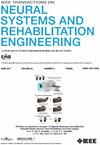Neuro-Modulation Analysis Based on Muscle Synergy Graph Neural Network in Human Locomotion
IF 4.8
2区 医学
Q2 ENGINEERING, BIOMEDICAL
IEEE Transactions on Neural Systems and Rehabilitation Engineering
Pub Date : 2025-04-04
DOI:10.1109/TNSRE.2025.3557777
引用次数: 0
Abstract
The coordination of muscles in human locomotion is commonly understood as the integration of motor modules known as muscle synergies. Recent research has delved into the adaptation of muscle synergies during the acquisition of new motor skills. However, the precise interplay between modulated muscle synergies during movement according to motion requirements remains unclear. Here, we aim to elucidate the alterations in locomotor synergies across various lower-limb motion strategies and motor tasks. Our findings reveal consistent weights of muscles in muscle synergies alongside varying timing activation aligned with specific motion requirements. It shows that spatial muscle synergies remain stable across different motor tasks, but humans adjusted the timing activation of these modules (temporal muscle synergies) to meet the motor requirements. To classify temporal muscle synergies and quantify connection weights for both self-connections and connections between muscle synergies, we employed a graph neural network. Our results demonstrate that muscle synergy 4, responsible for elevating the thigh to propel forward during the swing phase, experiences pronounced enhancement with changes in motion strategies. Furthermore, we observed a reduction in the self-connection of muscle synergy 2, implicated in stabilizing body posture, during motion tasks other than normal walking. Additionally, the connections between muscle synergy 2 and other synergies diminished, indicating more adaptation in muscle synergy 2 to achieve stabilization in more challenging motor tasks. The validity of these findings was verified through five-fold cross-validation, affirming the efficacy of our approach in elucidating neuro-modulation mechanisms in human locomotion. Our proposed methodology holds promising implications for the development of personalized training strategies, offering insights into the intricate interactions among different muscle synergies in accomplishing motor tasks.基于肌肉协同图神经网络的人体运动神经调节分析。
人体运动中肌肉的协调通常被理解为运动模块的整合,即肌肉协同作用。最近的研究已经深入到肌肉协同作用的适应过程中获得新的运动技能。然而,在运动过程中根据运动要求调节肌肉协同作用之间的确切相互作用仍不清楚。在这里,我们的目的是阐明在不同的下肢运动策略和运动任务中运动协同作用的变化。我们的研究结果揭示了肌肉协同作用中肌肉重量的一致性,以及与特定运动要求一致的不同时间激活。这表明空间肌肉协同作用在不同的运动任务中保持稳定,但人类调整了这些模块(颞肌协同作用)的激活时间以满足运动需求。为了对颞肌协同作用进行分类,并量化自连接和肌肉协同作用之间连接的连接权重,我们采用了图神经网络。我们的研究结果表明,在摇摆阶段,肌肉协同作用(负责抬升大腿向前推进)随着运动策略的改变而显著增强。此外,我们还观察到,在正常行走以外的运动任务中,与稳定身体姿势有关的肌肉协同作用的自我连接有所减少。此外,肌肉协同作用和其他协同作用之间的联系减弱,表明肌肉协同作用更适应于在更具挑战性的运动任务中实现稳定。通过五重交叉验证验证了这些发现的有效性,确认了我们的方法在阐明人类运动神经调节机制方面的有效性。我们提出的方法为个性化训练策略的发展提供了有希望的启示,为完成运动任务中不同肌肉协同作用之间复杂的相互作用提供了见解。
本文章由计算机程序翻译,如有差异,请以英文原文为准。
求助全文
约1分钟内获得全文
求助全文
来源期刊
CiteScore
8.60
自引率
8.20%
发文量
479
审稿时长
6-12 weeks
期刊介绍:
Rehabilitative and neural aspects of biomedical engineering, including functional electrical stimulation, acoustic dynamics, human performance measurement and analysis, nerve stimulation, electromyography, motor control and stimulation; and hardware and software applications for rehabilitation engineering and assistive devices.

 求助内容:
求助内容: 应助结果提醒方式:
应助结果提醒方式:


